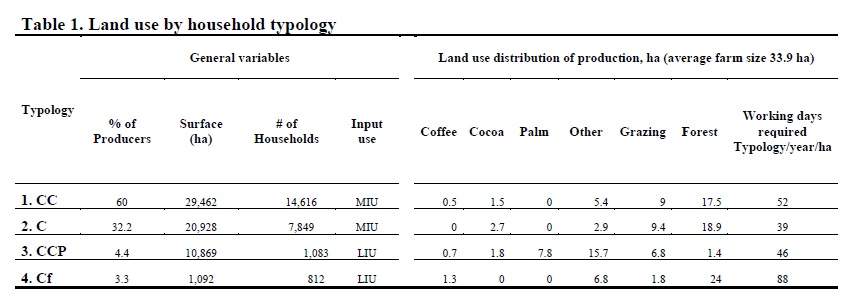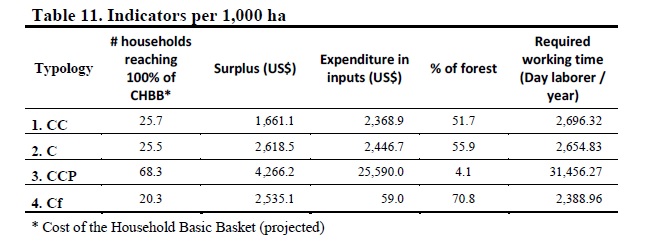Supporting smallholders’ livelihoods in fragile and biodiversity rich regions such as rainforests is a priority of many development agencies and national governments. These regions tend to be characterized by recent settlements, increasing population and infrastructure, as well as land use competing activities that put pressure upon fragile ecosystems. Research aimed at improving livelihood strategies often focuses on increasing yields and productivity, but fails to account for alternative measures such as improving agricultural practices, changing land use or improving commercialization. This paper uses household types defined according to different land use patterns in the northern Amazon region of Ecuador to explore limitations and identify future options for improving livelihood strategies based in the small-scale production of coffee and cocoa. Results for application to four types are discussed, which highlight the utility of the method and identify trade-offs in terms of environmental and social goals versus profitability. Lessons are drawn that can inform public policies oriented to improving livelihood strategies of small producers of coffee and cocoa in the Amazon region without compromising the environment.
The Documento de Trabajo FLACSO Ecuador 2016_02, written by Oswaldo Viteri from Escuela Politécnica Nacional, Jesús Ramos-Martín from FLACSO and Pedro L. Lomas from Universitat Autònoma de Barcelona, presents an evaluation of different household typologies and their relative performance and impact in the northern Amazon region of Ecuador, contributing to the debate on livelihoods, agricultural practices and sustainability.
The paper analyses four typologies of households: 1) those that plant coffee and cocoa (CC); 2) those with cocoa only (C); 3) those with coffee, cocoa and oil palm (CCP); and 4) those with only coffee (Cf). For each typology, the number of households is identified as well as the surface area, land use (including deforestation), working time for different activities, use of inputs, etc. In this manner, we are able to compare the performance of the different typologies not only in economic terms, but also regarding its environmental impact.
The paper also presents a scenario analysis assuming certain practices are in place and certain coefficients are respected under both land and time budget constraints. Moreover, the unit of analysis is set to 1,000 ha, so that we can see how many households can be supported by each household typology, and which would be the derived environmental impact. The conclusion is reached that typologies 1 (coffee and cocoa) and 2 (cocoa) may be the most interesting from a public policy perspective.
An improved version of this paper is currently under revision by the Journal of Rural Studies.
The working paper can be downloaded here from FLACSO Andes, and here from RePEc.

